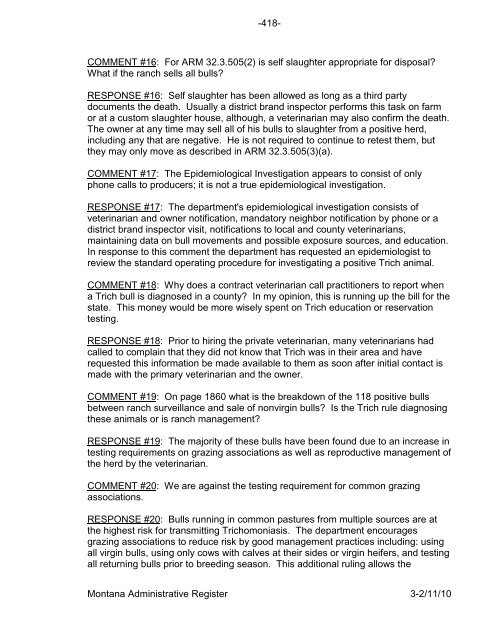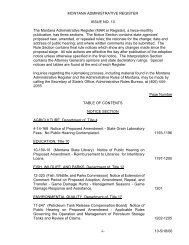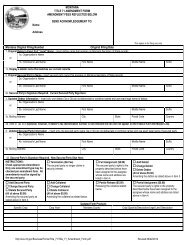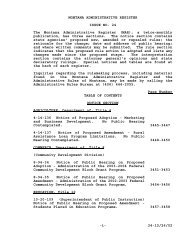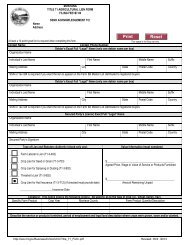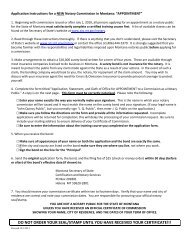Issue 3 - the Montana Secretary of State Website
Issue 3 - the Montana Secretary of State Website
Issue 3 - the Montana Secretary of State Website
Create successful ePaper yourself
Turn your PDF publications into a flip-book with our unique Google optimized e-Paper software.
-418-<br />
COMMENT #16: For ARM 32.3.505(2) is self slaughter appropriate for disposal<br />
What if <strong>the</strong> ranch sells all bulls<br />
RESPONSE #16: Self slaughter has been allowed as long as a third party<br />
documents <strong>the</strong> death. Usually a district brand inspector performs this task on farm<br />
or at a custom slaughter house, although, a veterinarian may also confirm <strong>the</strong> death.<br />
The owner at any time may sell all <strong>of</strong> his bulls to slaughter from a positive herd,<br />
including any that are negative. He is not required to continue to retest <strong>the</strong>m, but<br />
<strong>the</strong>y may only move as described in ARM 32.3.505(3)(a).<br />
COMMENT #17: The Epidemiological Investigation appears to consist <strong>of</strong> only<br />
phone calls to producers; it is not a true epidemiological investigation.<br />
RESPONSE #17: The department's epidemiological investigation consists <strong>of</strong><br />
veterinarian and owner notification, mandatory neighbor notification by phone or a<br />
district brand inspector visit, notifications to local and county veterinarians,<br />
maintaining data on bull movements and possible exposure sources, and education.<br />
In response to this comment <strong>the</strong> department has requested an epidemiologist to<br />
review <strong>the</strong> standard operating procedure for investigating a positive Trich animal.<br />
COMMENT #18: Why does a contract veterinarian call practitioners to report when<br />
a Trich bull is diagnosed in a county In my opinion, this is running up <strong>the</strong> bill for <strong>the</strong><br />
state. This money would be more wisely spent on Trich education or reservation<br />
testing.<br />
RESPONSE #18: Prior to hiring <strong>the</strong> private veterinarian, many veterinarians had<br />
called to complain that <strong>the</strong>y did not know that Trich was in <strong>the</strong>ir area and have<br />
requested this information be made available to <strong>the</strong>m as soon after initial contact is<br />
made with <strong>the</strong> primary veterinarian and <strong>the</strong> owner.<br />
COMMENT #19: On page 1860 what is <strong>the</strong> breakdown <strong>of</strong> <strong>the</strong> 118 positive bulls<br />
between ranch surveillance and sale <strong>of</strong> nonvirgin bulls Is <strong>the</strong> Trich rule diagnosing<br />
<strong>the</strong>se animals or is ranch management<br />
RESPONSE #19: The majority <strong>of</strong> <strong>the</strong>se bulls have been found due to an increase in<br />
testing requirements on grazing associations as well as reproductive management <strong>of</strong><br />
<strong>the</strong> herd by <strong>the</strong> veterinarian.<br />
COMMENT #20: We are against <strong>the</strong> testing requirement for common grazing<br />
associations.<br />
RESPONSE #20: Bulls running in common pastures from multiple sources are at<br />
<strong>the</strong> highest risk for transmitting Trichomoniasis. The department encourages<br />
grazing associations to reduce risk by good management practices including: using<br />
all virgin bulls, using only cows with calves at <strong>the</strong>ir sides or virgin heifers, and testing<br />
all returning bulls prior to breeding season. This additional ruling allows <strong>the</strong><br />
<strong>Montana</strong> Administrative Register 3-2/11/10


